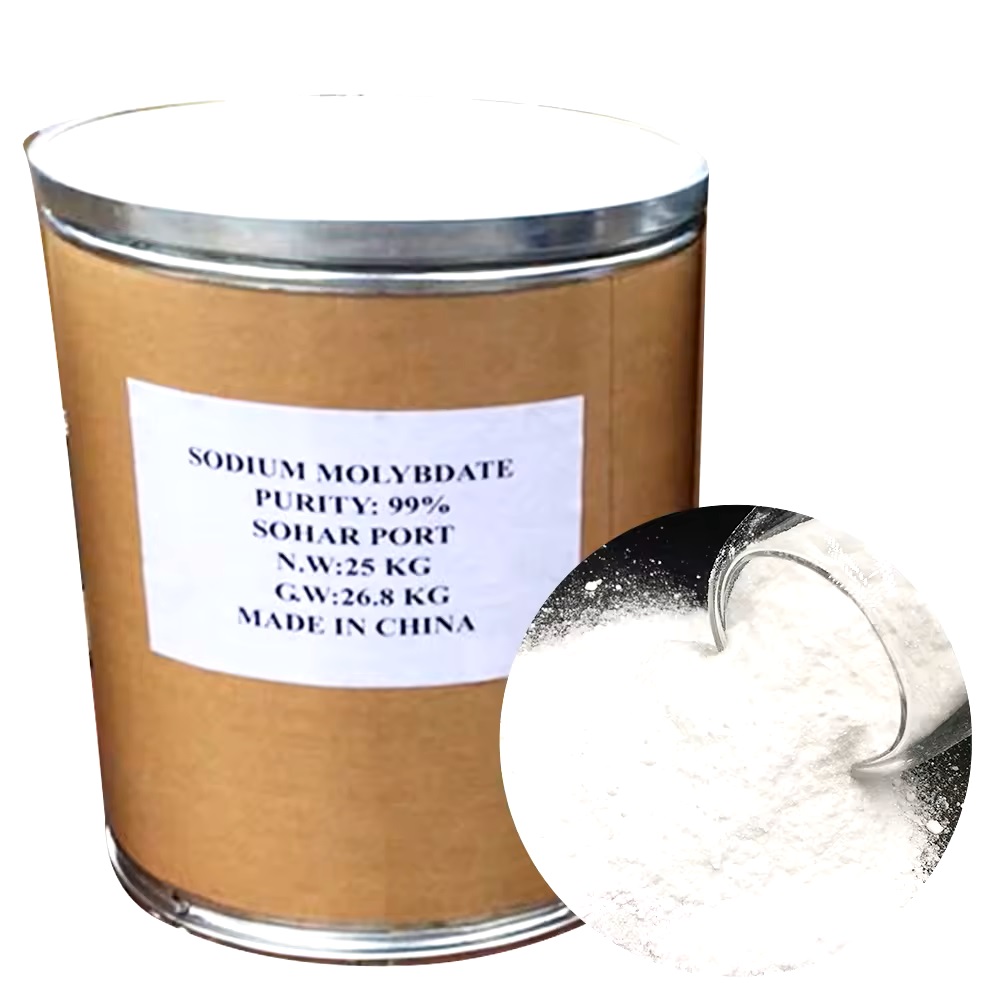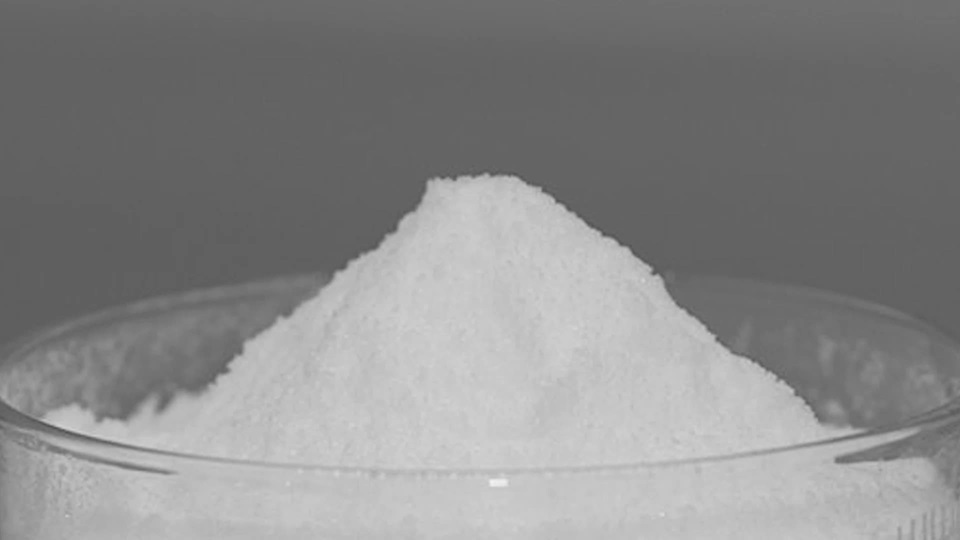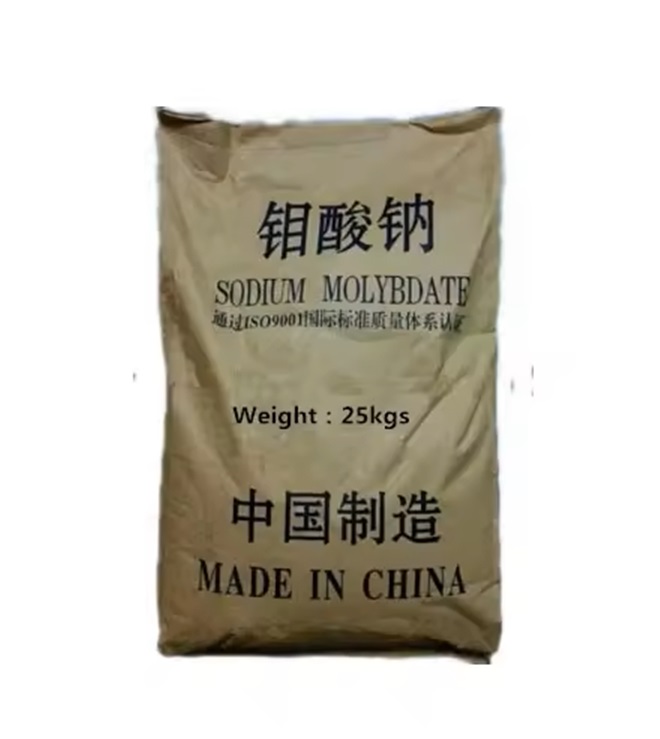We unleash your business potential by maximize the business innovation.
Send EmailSodium Molybdate, Disodium Molybdate, Natrium Molybdat , Sodium Molybdenum Oxide, Disodium Tetraoxo Molybdate, 7631-95-0, 106463-33-6, 14666-91-2
1. Physical and Chemical Properties
Sodium Molybdate (Na₂MoO₄) is a white crystalline compound.
-
Molecular Weight: 205.9 g/mol
-
Melting Point: 687 °C
-
Boiling Point: 1580 °C
-
Density: 3.78 g/cm³
-
Solubility: Highly soluble in water (84 g/100 ml at 100 °C)
-
Chemical Structure: Formed by bonding molybdate ion (MoO₄) with two sodium ions.
2. Applications
Sodium Molybdate is used in various industrial and agricultural fields:
-
Water Treatment: Helps precipitate harmful ions and impurities.
-
Metal Processing: Used as a corrosion inhibitor.
-
Agriculture: Serves as an essential nutrient source for plants and is included in fertilizers.
-
Chemical Industry: Used in the production of organic and inorganic chemicals.
3. Other Names
Sodium Molybdate is also known as:
-
Disodium Molybdate
-
Molybdic Acid, Disodium Salt
-
Sodium Molybdenum Oxide
-
Disodium Tetraoxo Molybdate.
4. CAS Numbers
The CAS numbers assigned to Sodium Molybdate are:
-
Anhydrous Form: 7631-95-0
-
Dihydrate Form: 10102-40-6.
5. Comparison with Other Molybdate Variants
Compared to other molybdate compounds, Sodium Molybdate has distinct properties:
-
Ammonium Molybdate: Primarily used as a catalyst.
-
Calcium Molybdate: Preferred in ceramic and glass production.
-
Potassium Molybdate: Commonly found in fertilizers
CAS: 7631-95-0;106463-33-6;14666-91-2
Molecular Formula: MoNa2O4
Names and Identifiers
| Name | Sodium Molybdate |
| Synonyms | molybdic CCRIS 5442 Sodium Molybdate disodiummolybdate Disodium molybdate Sodium molybdate(VI) disodium,(T-4)-Molybdate Natriummolybdat [German] Sodium molybdate (Na2MoO4) dioxo-disodiooxy-molybdenum Molybdic acid, disodium salt Molybdate (MoO42-), disodium, (T-4)- Molybdic acid (H2MoO4), disodium salt |
| CAS | 7631-95-0 106463-33-6 14666-91-2 |
| EINECS | 231-551-7 |
| InChI | InChI=1/Mo.2Na.4O/rMoNa2O4/c2-6-1(4,5)7-3 |
| InChIKey | TVXXNOYZHKPKGW-UHFFFAOYSA-N |
Physico-chemical Properties
| Molecular Formula | MoNa2O4 |
| Molar Mass | 205.91714 |
| Density | 3.78 g/mL at 25 °C (lit.) |
| Melting Point | 687 °C (lit.) |
| Water Solubility | It is soluble in water. |
| Appearance | Powder |
| Specific Gravity | 3.28 |
| Color | White |
| Exposure Limit | ACGIH: TWA 0.5 mg/m3NIOSH: IDLH 1000 mg/m3 |
| Merck | 14,8645 |
| Storage Condition | Room Temprature |
| Stability | Stable. Incompatible with strong oxidizing agents. |
| Sensitive | Hygroscopic |
| Refractive Index | 1.714 |
| MDL | MFCD00003486 |
| Physical and Chemical Properties | Character White rhomboid crystal. relative density 3.28 solubility slightly soluble in water, insoluble in acetone. |
| Use | For the preparation of molybdenum salt and dyes, pigments, catalysts, corrosion inhibitors, etc |
7631-95-0 - Risk and Safety
| Hazard Symbols | Xi - Irritant |
| Risk Codes | 36/37/38 - Irritating to eyes, respiratory system and skin. |
| Safety Description | S26 - In case of contact with eyes, rinse immediately with plenty of water and seek medical advice. S36 - Wear suitable protective clothing. |
| WGK Germany | 1 |
| RTECS | QA5075000 |
| TSCA | Yes |
Upstream Downstream Industry
| Raw Materials | Sodium hydroxide Molybdenum(VI) oxide Sodium hydroxide |
Nature
White rhombic crystals. Slightly soluble in 1.7 parts of cold water, 0.9 parts of hot water, 25 deg C 5% of the aqueous solution pH 9.0~10.O, insoluble in acetone. The water of crystallization was lost by heating to 100 °c and became anhydrous.
Preparation Method
molybdenum concentrate (the main component is MoS2) is oxidized and roasted to produce molybdenum trioxide, which is then leached with alkali solution to obtain sodium molybdate solution. The leaching solution is filtered and concentrated by evaporation. Sodium molybdate was obtained by cooling, crystallizing, centrifuging and drying the concentrated solution.
Use
molybdate is a new water treatment agent with low toxicity and low degree of environmental pollution. In order to obtain better corrosion inhibition effect, molybdate is often used with polyphosphate, gluconate, zinc salt and benzotriazole, which can not only reduce the amount of molybdate, but also improve the corrosion inhibition effect, the amount of molybdate was reduced from 200 ~ 500mg/LT to 4~6mg/L. In the film forming process of molybdate, dissolved oxygen must be present without calcium ions (or other divalent metal ions). Molybdate high thermal stability, can be used for high heat flux and local overheating of the circulating water system.
Safety
sodium molybdate is toxic but a low toxic compound. Molybdenum poisoning can cause joint pain, resulting in low blood pressure and blood pressure fluctuations, nerve dysfunction, metabolic process disorders. The maximum allowable concentration of soluble molybdenum aerosol is 2 mg/ma, and the dust is 4mg/m3. Wear the prescribed protective gear when contacting and using sodium molybdate. Pay attention to moisture. It shall be protected from rain and sun during transportation.
Reference Information
| Use | molybdate is a new type of water treatment agent with low toxicity and low environmental pollution. In order to obtain better sustained-release effect, molybdate is often used with polyphosphate, gluconate, zinc salt and benzotriazole, which can not only reduce the amount of molybdate, but also improve the corrosion inhibition effect, the dosage of molybdate decreased from 200 ~ 500mg/L to 4~6mg/L. In the film forming process of molybdate, dissolved oxygen must be present without calcium ions (or other divalent metal ions). Molybdate high thermal stability, can be used for high heat flux and local overheating of the circulating water system. Sodium molybdate can be used in the manufacture of alkaloids, ink, fertilizer, molybdenum red pigment and light-resistant pigment precipitation agent, Catalyst, molybdenum salt, can also be used in the manufacture of flame retardants and pollution-free cold water system of metal inhibitors, also used as zinc plating, polishing agents and chemical reagents. used as metal corrosion inhibitors, scale removal agents, bleach promoters and skin and hair protectants used as analytical reagents for the determination of alkaloids, dyes and the pharmaceutical industry used in the manufacture of alkaloids, ink, chemical fertilizer, molybdenum red pigment and light-resistant pigment precipitant, Catalyst, molybdenum salt, can also be used in the manufacture of flame retardants and pollution-free cold water system of metal inhibitor, also used as zinc plating, polishing agent and chemical reagent. The product can be used with dyes, inks, corrosion inhibitors, metal materials and other industrial products for the preparation of molybdenum salt and dyes, pigments, catalysts, corrosion Inhibitor |
| preparation | molybdenum trioxide is produced by oxidation roasting of molybdenum concentrate, and sodium molybdate solution is obtained by liquid alkali leaching, followed by Suction filtration, concentration, cooling, sodium molybdate can be obtained after centrifugation and drying. |
| safety | sodium molybdate is toxic, but a low toxicity compound. Molybdenum poisoning can cause joint pain, resulting in low blood pressure and blood pressure fluctuations, nerve dysfunction, metabolic process disorders. The maximum allowable concentration of soluble molybdenum aerosol is 2 mg/m, and the dust is 4 mg/m. Wear the prescribed protective gear when contacting and using sodium molybdate. Pay attention to moisture. It shall be protected from rain and sun during transportation. |
| production method | 1. Laboratory can be obtained by melting a mixture of molybdenum trioxide and sodium carbonate. The raw material molybdenite (main component MoS2) is oxidatively roasted to produce crude molybdenum oxide, which is washed with nitric acid to remove impurities, then dissolved in aqueous sodium hydroxide solution, and heated and concentrated to obtain sodium molybdate Na2MoO4 · 2H2O dihydrate. Anhydrous was obtained by heating to 100 °c. |


